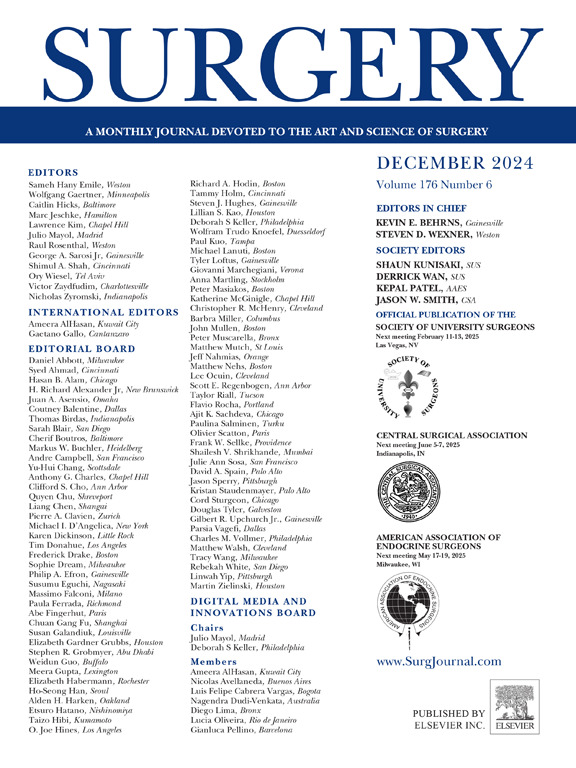营养和炎症状态动态反映局部晚期直肠癌术前治疗反应并预测预后:一项多机构回顾性分析。
IF 3.2
2区 医学
Q1 SURGERY
引用次数: 0
摘要
背景:全身性炎症是肿瘤中最具代表性的肿瘤-宿主相互作用,是肿瘤中重要的宿主特性,恶性肿瘤的发展可能导致营养状况的损害。本研究旨在探讨营养和炎症指标对局部晚期直肠癌(LARC)新辅助放化疗疗效和预后的潜在预测能力。方法:本研究采用多机构资料。2012 - 2014年共纳入507例适合新辅助放化疗的IIA-IIIC期LARC患者(训练组262例,验证组245例)。晚期肺癌炎症指数(ALI)反映营养和炎症状况。ALI以体重指数(BMI) ×白蛋白×中性粒细胞/淋巴细胞计算。采用Logistic回归模型确定术前治疗反应的预测因素。采用Cox多元回归模型分析影响无病生存期(DFS)和总生存期(OS)的因素。结果:在训练队列中,观察到高预处理ALI患者与年轻患者、从不吸烟、相对较高的BMI和早期病理TNM分期相关。受试者工作特征曲线显示,与其他炎症指标相比,ALI预处理及其变化是决定预后的最重要因素。全组10年DFS和OS率分别为63.6%和74.1%。结论:我们的研究结果表明,ALI作为一种可行的营养和炎症状态指标,在预测新辅助放化疗疗效和预后方面比其他炎症指标具有更好的效率。本文章由计算机程序翻译,如有差异,请以英文原文为准。
Nutritional and inflammatory status dynamics reflect preoperative treatment response and predict prognosis in locally advanced rectal cancer: A retrospective multi-institutional analysis
Background
Systemic inflammation, as an important host property, is the most representative tumor-host interactions in cancer, and the development of malignant neoplasms may contribute to impairment on nutritional status. This study aimed to investigate the potential ability of nutritional and inflammatory index in predicting neoadjuvant chemoradiotherapy efficacy and prognosis in locally advanced rectal cancer (LARC).
Methods
This study was conducted using multi-institutional data. A total of 507 patients (262 in the training and 245 in the validation cohort) with stage IIA-IIIC LARC fit for neoadjuvant chemoradiotherapy were recruited from 2012 to 2014 were included in this study. Advanced lung cancer inflammation index (ALI) reflected nutritional and inflammatory status. The ALI was calculated as body mass index (BMI) × albumin × neutrophil/lymphocyte. Logistic regression model was used to identify predictive factors for preoperative treatment response. Cox multivariate regression models were used to analyze the factors affecting disease-free survival (DFS) and overall survival (OS).
Results
In the training cohort, patients with high pretreatment ALI were observed to be associated with young patients, never smoked, relatively high BMI, and early-stage pathologic TNM staging. The receiver operating characteristic curve indicated that pretreatment ALI and its changing was the single most important factor determining outcomes than other inflammatory indicators. The 10-year DFS and OS rates of the whole group were 63.6% and 74.1% respectively. Patients with low pretreatment ALI and ALI change had significantly poorer 10-year DFS (P < .001 and P = .001) and 10-year OS (P = .002 and P = .025) rates than those with high ALI and ALI change. Similar findings were observed in the validation cohort. Multivariate analysis revealed that pretreatment ALI (P = .047 and P = .006) and ALI change (P = .027 and P = .041) were identified as independent prognostic factors for DFS. Meanwhile, high pretreatment ALI (P = .020 and P = .010), high systemic immune-inflammation index (SII) change (P = .040 and P = .012) and clinical stage T2-T3 were independent protective factors for OS. Furthermore, multivariate logistic regression analyses revealed that pretreatment ALI, ALI change, and SII change could independently predict efficacy of neoadjuvant chemoradiotherapy.
Conclusion
Our results suggest that as a feasible indicator of nutritional and inflammatory status, the ALI shows better efficiency than other inflammatory indicators in predicting efficacy of neoadjuvant chemoradiotherapy and prognosis.
求助全文
通过发布文献求助,成功后即可免费获取论文全文。
去求助
来源期刊

Surgery
医学-外科
CiteScore
5.40
自引率
5.30%
发文量
687
审稿时长
64 days
期刊介绍:
For 66 years, Surgery has published practical, authoritative information about procedures, clinical advances, and major trends shaping general surgery. Each issue features original scientific contributions and clinical reports. Peer-reviewed articles cover topics in oncology, trauma, gastrointestinal, vascular, and transplantation surgery. The journal also publishes papers from the meetings of its sponsoring societies, the Society of University Surgeons, the Central Surgical Association, and the American Association of Endocrine Surgeons.
 求助内容:
求助内容: 应助结果提醒方式:
应助结果提醒方式:


